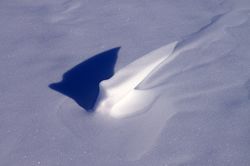Two nights ago it snowed. They were thin and microscopic flakes. I let them fall on my jacket to watch them better. They were infinitesimal points. The most expert asserted that they were not carried by the wind, but new, just shaped. Right before sleeping, I looked out: there was a layer of 3 cm, light like a veil. The following morning there was no more sign of it, not even in the most sheltered places. Everything was like before, as if nothing had happened.
Since we were children, we learned to associate the idea of cold with that regarding snow; the colder it is the more abundant it snows. Then, at school you learn that Antarctica is the coldest continent of the world and in a moment you begin dreaming about how much snow it can fall there: 3, 5, 10, 100 metres of snow, insurmountable and massive walls by which you invent impossible exploits shortly before falling asleep in the rainy nights of March. The very moment of the year you have to put aside definitively the expectation for new snowfalls.
 “In Antarctica that does not happen..” you think, “..in Antarctica children are always happy; they watch so much snow falling down!” But it is not so.
“In Antarctica that does not happen..” you think, “..in Antarctica children are always happy; they watch so much snow falling down!” But it is not so.
In Antarctica it falls far less snow than you usually think. On the coast a little more, but on the inland very little: the equivalent of 2,5 cm of water. It is surely less than that on the top of our Alps. What is very strange here is that snow, simply, does not melt.
Never.
Here the life of a snowflake does not resemble our home-grown snow. Instead, it is like the grains of sand in the desert. It falls, sure, but then it rises, thanks to very violent winds, it travels along boundless distances, beats against stones and rocks, frosting them like glass, it mixes with grains of sand, then, sometimes, it settles, in order to rise again and continue its pilgrimage.
Melting, a fancy, that is clear, but it can be entrapped and accumulated under other snow. At that moment it starts getting compact under the weight of overhanging snow, flakes get closer and the empty spaces reduce until, after about one thousand years and at about 80 m deep (Italian-French project EPICA), it becomes real ice, solid, very hard. That is its destiny, but only more immediate, as it has not come to an end yet.
Ice does not stay still; it moves radially from the centre to the exterior, just where it has to go: to the ocean, where else? But it arrives slow, very slow, in a surreal slowness, exasperating, irritating. Hundreds of thousands years. Hundreds of thousands….I do not know what you think about, but slowness arouses dread, awe, respect, much more than speed… slowness evokes the cosmos, that cannot be stopped. It manages to make useless and a little droll the rest, man and speed included.
Maybe proceedings here are like this, in this bubble where everything is broadened, expanded and where a simple cycle of light is spread on 365 days.